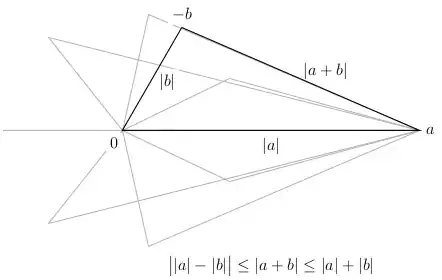Suppose you supply two arbitrary real numbers $a$ and $b$. Let's construct a "triangle" (on the number line) whose vertices are $0$, $a$, and $-b$. (We're free to choose vertices as we like; pick $-b$ instead of $b$ for reasons to be explained in a moment.)
Since the distance between real number $x$ and $y$ is $|x - y|$, the sides of our "triangle" have lengths
$$
|a - 0| = |a|,\qquad
|-b - 0| = |-b| = |b|,\qquad
|a - (-b)| = |a + b|.
$$
(Now you know why we picked $-b$: To get $a + b$ inside the absolute value.:)
Two sides of our triangle have length $|a|$ and $|b|$. It's reasonable to ask: Based on this information alone, how long can the third side be?
It should be fairly clear geometrically that:
The third side cannot exceed $|a| + |b|$, the sum of the lengths of the known sides. In symbols,
$$
|a + b| \leq |a| + |b|.
$$
This is the triangle inequality.
The third side cannot be shorter than the distance between the real numbers $|a|$ and $|b|$. In symbols
$$
|a + b| \geq \bigl||a| - |b|\bigr|.
$$
This is the reverse triangle inequality.
In your particular example, if two sides of a triangle have length $2$ and $5$, then the third side cannot be shorter than $|2 - 5| = |-3| = 3$, and cannot be longer than $|2 + 5| = |7| = 7$. (On the number line, the sides of a "triangle" are parallel, so the third side is actually equal either to $3$ or to $7$. However, similar-looking inequalities hold for distance in the plane, or in space, or in higher-dimensional spaces. In these spaces, the sides of a triangle need not be parallel. In the plane, the third side of your triangle could have any length between $3$ and $7$.)

One nice proof of the triangle inequalities (for real numbers) is to show that if $x$ and $c$ are real numbers, then $|x| \leq c$ if and only if $-c \leq x \leq c$. (That is, an upper bound on the absolute value of $x$ can be "traded" for a symmetric pair of upper and lower bounds on $x$.)
Clearly,
\begin{align*}
-|a| &\leq a \leq |a| &&\text{for all real $a$,} \\
-|b| &\leq b \leq |b| &&\text{for all real $b$.} \\
\text{ Adding,}\quad
-\bigl(|a| + |b|\bigr) &\leq a + b \leq |a| + |b|. &&
\end{align*}
The third line has the form $-c \leq x \leq c$ for $x = a + b$ and $c = |a| + |b|$, and so can be "traded" for $|x| \leq c$, namely, for
$$
|a + b| \leq |a| + |b|.
$$
Note, in addition, that
$$
|a - b| = |a + (-b)| \leq |a| + |-b| = |a| + |b|.
$$
To prove the reverse triangle inequality, we apply the preceding reasoning to the equations
\begin{align*}
b &= (a + b) - a & \text{obtaining}\quad |b| &\leq |a + b| + |a|, \\
a &= (a + b) - b & \text{obtaining}\quad |a| &\leq |a + b| + |b|.
\end{align*}
Rearranging the inequalities on the right, we have
$$
-|a + b| \leq |a| - |b| \leq |a + b|.
$$
This chain of inequalities is also of the form $-c \leq x \leq c$, this time with $x = |a| - |b|$ and $c = |a + b|$, and so can be "traded" for
$$
\bigl||a| - |b|\bigr| \leq |a + b|.
$$
